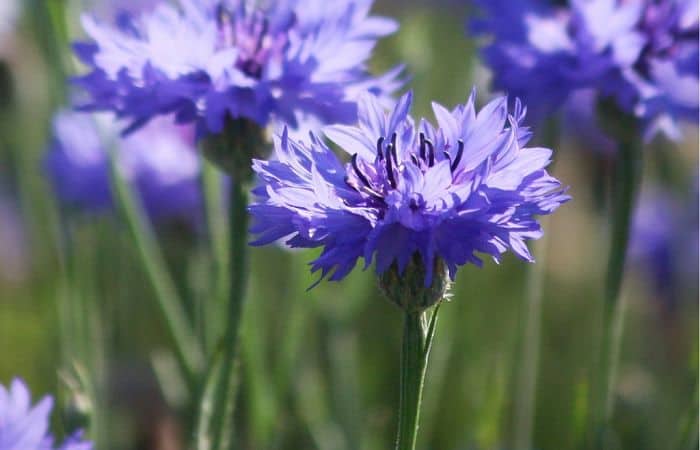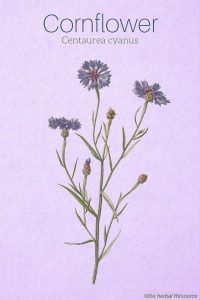Botanical Name: Centaurea cyanus.
Other Common Names: Bachelor’s button, blueblow, blue cap, blue poppy, bluebonnets, bluebottle, hurtsickle, kornblomst (Danish), Kornblume (German), blåklint (Swedish), Kornblom (Norwegian), kornblóm (Icelandic), azulejo (Spanish), bleuet, casse lunette (French), ruiskaunokki (Finnish).
Habitat: Originating in Mediterranean Europe and Western Asia, cornflowers must have entered Great Britain sometime during the Iron Age, where it is first found in the archaeological record.
Its spread to Australia and many Northern Hemisphere countries including the United States and Canada was facilitated by agricultural exports from its native habitat.
It is now endangered in its native habitats due to modern agricultural practices, mostly because of excessive use of pesticides. Today, cornflower is widely cultivated as an ornamental plant.
The plant prefers full sun and does not tolerate shade. It grows best in porous, dry or moist, nutrient-rich soils.
Description: Cornflowers have light green branching stems topped by deep blue floral centers that are ringed evenly by pointed florets of the same intense blue hue.
Plants can grow to 30 inches in height with a radius of 12 inches.
Cornflower is in flower from June to August, and the seeds ripen from August to October. The flowers are hermaphrodite (have both male and female organs).
Plant Parts Used:
It is primarily the dried flower heads that have been used medicinally. The leaves and seeds have also been used to some extent in herbal medicine.
Traditional Uses and Health Benefits of Cornflower
‘
Active Ingredients and Substances: In addition to containing essential nutrients that include biotin (vitamin B7) and calcium, the flower buds also include other active compounds:
• Anthocyanins: Protocyanin, flavones.
• Antioxidants: Ascorbic acid (vitamin C), folate.
• Benzopyrone: Coumarin.
• Polyacetylenes: Cuprene.
• Polyphenols: Tannin.
• Sesquiterpene lactones: Cnicin.
Internal Medicinal Uses of Cornflowers
The plant’s medicinal value lies primarily in its anti-inflammatory properties. Taken internally as an herbal tea, it is thought to aid in soothing stomach ulcers, while rinsing with the tea is used to speed the healing of sores or bleeding gums in the mouth.
The tea can also be good for improving digestion, and the herb’s high antioxidant content aids in detoxifying the liver.
Stronger infusions of the flower buds have been used to treat urinary tract infections, as the properties of the plant include antibiotic and antiseptic qualities.
Taken internally as a tea, the flowers can also impart their antibiotic and antioxidant properties as a preventative for warding off illnesses like the common cold.
An infusion of the seeds has been used historically in Europe for treating constipation. A gentle infusion of the petals is also said to treat yeast infections in women when applied internally.
Cornflowers are also thought to stimulate the appetite when taken as a tea.
External Medicinal Uses
The natural tannin found in the plant helps to bind proteins, which makes its use as a wound treatment particularly effective. It can assist in stopping bleeding in open wounds and bleeding gums.
The addition, the phytochemical coumarin acts as an anticoagulant by crushing the leaves and applying their juice directly to a wound. The plant also has a beneficial effect when the flower heads and crushed leaves are applied as a poultice to bruises, aching muscles, and inflamed joints, due to its anti-inflammatory qualities.
A highly concentrated infusion of the flower heads, either fresh or dried, can be used as a wash on the scalp to get rid of dandruff. Furthermore, the herb can be used to sooth eczema flare-ups.
Historically, cornflower is renowned for its use as a soothing eyewash, especially in France. With its anti-inflammatory qualities paired alongside its antiseptic properties, the herb is believed to be an effective eyewash when treating conjunctivitis.
Due to the plant’s astringent qualities, it is also useful in treating puffy eyes or the dark circles that can accompany other eye complaints.
An Edible Plant and A Natural Dye
As an addition to the herb’s medicinal uses or as an ingredient in black tea blends, the cornflower can be used for a splash of color as well as for its slightly astringent flavor.
Steeping the blooms in clear alcohols like vodka also produces a deeply-hued blue tincture that has an aesthetic use as a component in cocktails and may have beneficial medicinal uses, although using the herb in the form of tea or infusion is more practical.
Cornflowers make a beautiful addition to fresh salads, where their nutritional value adds calcium, mineral salts, folate and vitamin C to the diet.
The powdered florets can also be added to sugar when making colored cake frosting or other confectionery.
Adding cornflowers to alum water and boiling the mixture creates a pleasing blue hue that can be used to dye linen or wool yarn. Historically, cornflowers have also been used to produce ink colors and watercolor washes.
Added to potpourris, the petals provide a spot of bright blue as well as a delicate scent.
Superstitions, Claims and Traditional Uses of Cornflower
In ancient Egypt, cornflowers were associated with renewal or revival, as they appeared each year growing amidst cereal crops like wheat and barley. Depictions of the plant date back to the Neolithic era, almost 4,000 years BCE. Surviving palace walls from the Amarna Period show depictions of cornflowers and Egyptian pharaoh Tutankhamun was buried with a woven collar that included cornflowers for their allusion to resurrection and fertility.
In Greek mythology, the hero Achilles was shot with a poisoned arrow by Heracles. His wound was treated by the application of cornflowers. The wise centaur, Chiron, was also said to have used cornflowers to heal wounds after a battle.
During the Middle Ages, cornflowers were used to symbolize the Virgin Mary. Sandro Botticelli, an Italian painter of the Early Renaissance, used cornflowers in his famous painting “Birth of Venus.” Thallo the Hora of Spring (a goddess of spring flowers and summer fruits) standing on the right of Venus is wearing a dress covered with cornflowers, symbolizing springtime.
The Habsburg coat of arms used by Charles V, the ruler of Spain from 1516 and of the Holy Roman Empire from 1519, included depictions of cornflowers, which symbolized fidelity.
The famous abbess and healer, Hildegard of Bingen, mentioned cornflowers in her medicinal treatise, Physica, in the late 12th century.
Nicholas Culpepper was a renowned botanist and healer during the 1600s. His writings on the various medicinal properties of plants were considered authoritative for centuries, and he recommended cornflowers for use in treating broken blood vessels, scorpion stings, fevers caused by pestilence and as an eyewash.
Dosage and Administration
When added to herbal teas, one gram of the crushed flowers per cup of water is an appropriate strength.
To make an herbal infusion of the flower heads for use as an eyewash, take two teaspoons of the dried petals and add to a steaming cup of water. Allow to cool and then strain the infusion before using as a refreshing wash for tired eyes or splashing on irritated skin.
For flaky scalp or other skin ailments, a stronger infusion of the petals can be made, applying a poultice of the flower heads directly onto affected areas. A warm poultice is also useful for aching joints. Several tablespoons of the dried or fresh flower heads can be mashed and steeped in steaming water for 15 minutes before applying.
Possible Side Effects and Interactions of Cornflower
Therapeutically, it can be used both internally as well as externally without the risk of any major side effects.
Those with a known allergic sensitivity to ragweed, daisies, dandelions or sunflowers will need to avoid cornflowers, due to the possibility of a similar allergic reaction. Those who are pregnant or nursing should consult a physician before ingesting any tinctures or infusions.
As cornflowers have an anti-inflammatory characteristic, their use in conjunction with other anti-inflammatory drugs should be carefully monitored. Those who are being treated for urinary tract stones should also avoid large quantities of infusions of the flower heads, as its diuretic properties will act in addition to the treatment already applied by other medications.
The German Commission E does not indicate any risks or side effects associated with a moderate use of cornflower.
Supporting References
Bown, Deni: The Royal Horticultural Society New Encyclopedia of Herbs & Their Uses. London, Dorling Kindersley 2002.
van Wyk, Ben-Erik & Michael Wink: Medicinal Plants of the World. Portland, Oregon, Timber Press 2004.
Volák, Jan & Jiri Stodola: The Illustrated Book of Herbs. London, Caxton Editions 1998.
Wren, R.C.: Potter’s New Cyclopedia of Botanical Drugs and Preparations. Essex, Saffron Walden 1988.
Thordur Sturluson
Latest posts by Thordur Sturluson (see all)
- What is the Difference Between Hemp and Marijuana? - June 3, 2019


The flower used to treat Achilles was Achillea not cornflower.